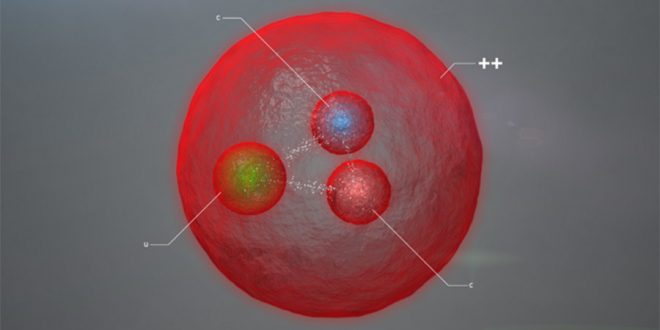Scientists at the Large Hadron Collider have found a new subatomic particle that could provide clues about one of the forces that holds much of the stuff in the universe together.
The new heavy particle, named Xi-cc++ (pronounced Ksī-CC plus-plus), was discovered by the Large Hadron Collider beauty (LHCb) experiment and is part of a family of “doubly charmed baryons”.
Baryons are subatomic particles made up of quarks. Protons and neutrons are the most common baryons. Quarks are even smaller particles that come in six types, two common types that are light and four heavier types.
The particle has long been predicted to exist by the Standard Model theory of particle physics, but this is the first time scientists have been able to confirm their existence.
Professor Chris Parkes, deputy spokesperson for LHCb and Head of Accelerator, Nuclear and Particle Physics at The University of Manchester, said “This discovery opens up a new field of particle physics research. An entire family of doubly charmed baryons, related to this particle, now await discovery!”
Nearly all the matter that we see around us is made of baryons, which are common particles composed of three quarks, the best-known being protons and neutrons. But there are six types of existing quarks, and theoretically many different potential combinations could form other kinds of baryons. Baryons so far observed are all made of, at most, one heavy quark such as a bottom or charm quark.
“This discovery opens up a new field of particle physics research. An entire family of doubly charmed baryons, related to this particle, now await discovery!”
Professor Chris Parkes
University of Glasgow physicist Dr Patrick Spradlin, who led the research and announced the findings at the European Physical Society Conference on High Energy Physics in Venice, said “The properties of the newly discovered baryon shed light on a longstanding puzzle surrounding the experimental status of baryons containing two charm quarks, opening an exciting new branch of investigation for LHCb.”
The observation of this new baryon proved to be challenging and has been made possible owing to the high production rate of heavy quarks at the LHC and to the unique capabilities of the LHCb, one of the four main experiments at CERN solving the mysteries of our universe, which can identify the decay products with excellent efficiency. The Ξ_cc^(++) baryon was identified via its decay into a Λc+ baryon and three lighter mesons K-, π+ and π+.
The observation of the Ξ_cc^(++) in LHCb raises raises expectations that other representatives of the doubly charmed baryon family could be detected. They will now be searched for at the LHC.
The Large Hadron Collider, located in a 27-kilometer (16.8-mile) tunnel beneath the Swiss-French border, was instrumental in the discovery of the Higgs boson.
Agencies/Canadajournal
 Canada Journal – News of the World Articles and videos to bring you the biggest Canadian news stories from across the country every day
Canada Journal – News of the World Articles and videos to bring you the biggest Canadian news stories from across the country every day



